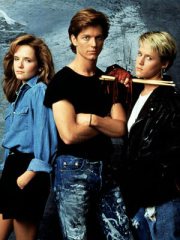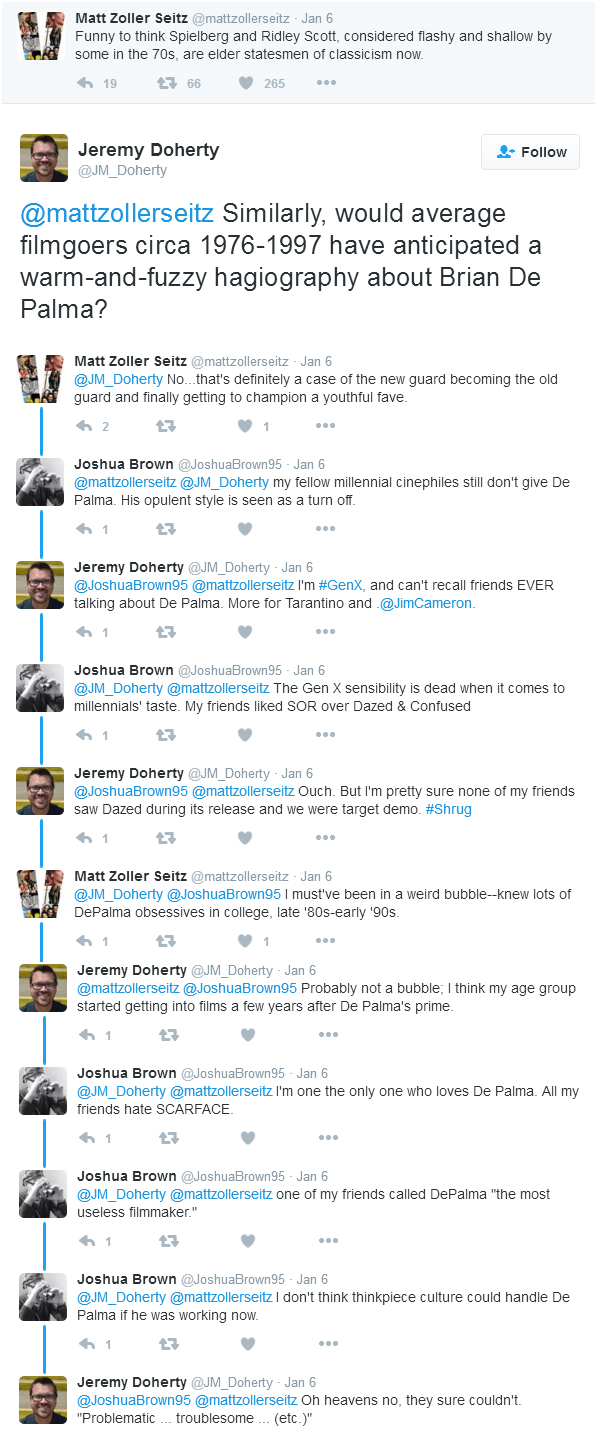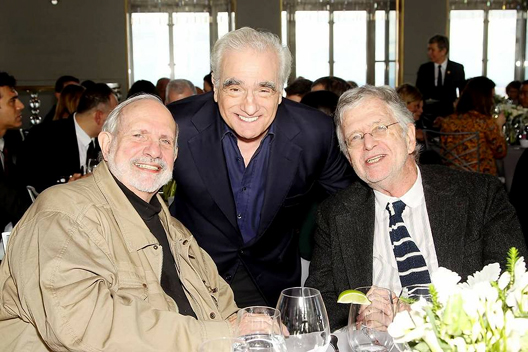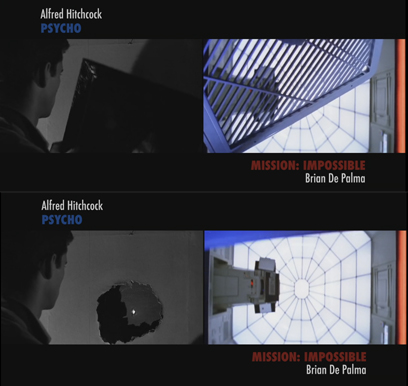WHAT DO BRIAN DE PALMA'S CHARACTERS DREAM OF?
What do Brian De Palma's characters dream of?
Updated: Wednesday, March 22, 2017 4:46 AM CDT
Post Comment | Permalink | Share This Post
 Hello and welcome to the unofficial Brian De Palma website. Here is the latest news: |
|---|
E-mail
Geoffsongs@aol.com
-------------
Recent Headlines
a la Mod:
Listen to
Donaggio's full score
for Domino online
De Palma/Lehman
rapport at work
in Snakes
De Palma/Lehman
next novel is Terry
De Palma developing
Catch And Kill,
"a horror movie
based on real things
that have happened
in the news"
Supercut video
of De Palma's films
edited by Carl Rodrigue
Washington Post
review of Keesey book
-------------
Exclusive Passion
Interviews:
Brian De Palma
Karoline Herfurth
Leila Rozario
------------
------------
| « | March 2017 | » | ||||
| S | M | T | W | T | F | S |
| 1 | 2 | 3 | 4 | |||
| 5 | 6 | 7 | 8 | 9 | 10 | 11 |
| 12 | 13 | 14 | 15 | 16 | 17 | 18 |
| 19 | 20 | 21 | 22 | 23 | 24 | 25 |
| 26 | 27 | 28 | 29 | 30 | 31 | |
De Palma interviewed
in Paris 2002
De Palma discusses
The Black Dahlia 2006

Enthusiasms...
Alfred Hitchcock
The Master Of Suspense
Sergio Leone
and the Infield
Fly Rule
The Filmmaker Who
Came In From The Cold
Jim Emerson on
Greetings & Hi, Mom!
Scarface: Make Way
For The Bad Guy
Deborah Shelton
Official Web Site
Welcome to the
Offices of Death Records
From the beginning (the end of the 60s) and until today (Passion, 2012), and tomorrow still certainly, the staging of Brian De Palma will never cease to play the game of cat and mouse. But in a version where the roles are constantly reversed: to be beaten at one's own game...Split screens, double focal lengths, slow motion, 360-degree panning, dives and counter-dives, multiplication of angles and axes, aerial camera, so many ways to expose a mise en scène or to sum up all reality to its mise en scène. In short, a sophisticated device of signs as so many indices that give the viewer the illusion of his omniscience: if all reality holds in its staging as in a box, then nothing is supposed to escape the one who Looks in the box. De Palma likes nothing more than to drive the spectator-voyeur, to make him go around the owner, to direct his glance and to designate a detail (to better conceal another). Is that not the very subject of Body Double?
The vertical plunge holds a place of choice in the De Palma fireworks. It is even a recurring motif of his work, a motif that is often quickly interpreted as a tribute to Hitchcock (the opening credits of North by Northwest, the staircase of Psycho, the tower of Vertigo, the pipe organ of Secret Agent…). In the visual economy of the cinema of De Palma, it is also the ultimate ruse: the zenithal point of view seems to make each spectator a god. Nothing escapes it apparently, everything is given to see and everything is seen, the foreground doubled as background. But this phantasm of all power makes him forget his constitutive infirmity: the spectator, like a character of De Palma, has no eyes in the back (if it were otherwise, Carlito would still be alive ...). It is there, at his back, that De Palma stands, and with him the truth of all his staging: there is always someone or something that looks at the one who looks. As in a game of mirrors, or in the painting by Magritte (Not to be Reproduced), one is always seen as "the eye was in the grave and looked at Cain" (Victor Hugo , La Conscience).
 Salon's Kevin Smokler spoke with Howard Deutch and Lea Thompson, who met and fell in love 30 years ago while (respectively) directing and acting in the John Hughes movie Some Kind Of Wonderful. Deutch talks about landing in "movie jail" after taking advice from Brian De Palma, although he would eventually end up being brought back in to make the movie. Here's the excerpt:
Salon's Kevin Smokler spoke with Howard Deutch and Lea Thompson, who met and fell in love 30 years ago while (respectively) directing and acting in the John Hughes movie Some Kind Of Wonderful. Deutch talks about landing in "movie jail" after taking advice from Brian De Palma, although he would eventually end up being brought back in to make the movie. Here's the excerpt:Here in the present, how often does “Some Kind of Wonderful” come up for each of you?Howard Deutch: Quite a bit, actually. Which is ironic because it wasn’t considered a hit when it came out. But it’s a meaningful movie to people and I met my wife on set so it’s a meaningful movie to me.
Most people talk about it like I talk about a movie I didn’t direct and I don’t think the other person has heard of. They don’t talk about “Some Kind of Wonderful” as completely unknown or an underdog but they cherish it because it hadn’t been this massive hit movie. It’s not like they’re saying, “Have you ever seen this little movie, “Back to the Future?”
Lea Thompson: It wasn’t a bomb, but definitely a disappointment. Yet it seems to have a broad base around the world that are really touched by it and quote it. I just asked on Instagram and Twitter about everyone’s favorite line from the movie and was amazed how many people have so many different memories of it.
I also hear from more men than women who love it, but I can’t tell you why. Maybe because it’s two girls fighting over a guy? Or because it’s about a guy trying to find himself? I also hear from a lot of gay women who love Watts.
You both have worked more or less continuously in films and television since 1987. Where do you see “Some Kind of Wonderful” in the arc of your work?
Deutch: I had only made one other movie up to that point and couldn’t cast the role Eric Stoltz ended up playing. Around that time, I ended up on a plane with (director) Brian De Palma, whom I didn’t really know. He told me, “If you can’t cast it, don’t make it.” I mentioned this to John and suggested I do one of his other scripts and ended up in movie jail. Paramount locked the door of my office.
Martha Coolidge (director of “Valley Girl”) was brought on to replace me. The script was originally a broad comedy and John made rewrites to take it in the direction of Martha’s sensibility, which was darker and more adult. Martha cast Eric. But when she and John had disagreements, I was brought back with a different script, a leading actor. A different movie.
Thompson: I was 26 when I made “Some Kind of Wonderful.” Right before, I had made “Howard the Duck,” which got terrible reviews. I thought my career was over. Eric Stoltz, whom I had become friends with while working together on both “Back to the Future” [Stolz was the original Marty McFly] and “The Wild Life,” acting as a messenger for Howard, delivered the script to my house. Howie saw me as right for Amanda even though I had already turned it down because I thought Watts [the character ultimately played by Mary Stuart Masterson] was the better part. I needed a job. Amanda was my second chance.
 A.V. Club's Mike D'Angelo analyzes the split screen sequence in today's "Scenic Routes" column:
A.V. Club's Mike D'Angelo analyzes the split screen sequence in today's "Scenic Routes" column:Resolved: Split screen is an underutilized cinematic device.That’s how I would have phrased it back in my high-school debating days. Which seems appropriate, because—as was often the case with debate resolutions—I’m not 100 percent certain that I believe it, even though coming up with arguments that support it isn’t terribly difficult. For one thing, split screen is employed so infrequently that I associate it almost exclusively with Brian De Palma, who loves to construct elaborate, suspenseful set pieces that show two or more events unfolding simultaneously. And it’s easy to wonder, after being thrilled by one of De Palma’s dual orchestrations, why he’s long enjoyed a near-monopoly on this approach, which takes such striking advantage of the medium’s intrinsic qualities—that is, of the ability to manipulate time and/or space. I still haven’t seen Andy Warhol’s Chelsea Girls, which I believe is split screen from start to finish… but I have seen Forty Deuce, a 1982 drama directed by Warhol associate Paul Morrissey, in which, throughout the film’s very stagy second half, the frame constantly offers two separate angles of the same action, side by side. It’s mostly a distraction—as I said, I’m not entirely convinced of my own thesis here—but I’ve always sensed untapped potential in the idea.
My favorite recent use of split screen, though, involves the manipulation not of time or space, exactly, but of the protagonist’s consciousness. (500) Days Of Summer is a gimmicky movie in a lot of ways, starting with the parenthesis in its title; it has an omniscient narrator, jumps all over the place chronologically, and at one point sees its hero, played by Joseph Gordon-Levitt, perform an impromptu musical number, accompanied by dancing extras and animated birds. Most of this quirkiness can be filed under “cutesy,” and will either delight or irritate, according to taste. But the movie does have a more downbeat side, which comes most strongly to the fore during a brief sequence toward the end, when Gordon-Levitt’s Tom shows up at a party being thrown by ex-girlfriend Summer (Zooey Deschanel). Screenwriters Scott Neustadter and Michael H. Weber want to show us how what happens at the party deviates from what Tom imagined would happen, and either they or director Marc Webb decided to do so by splitting the frame down the middle, with “Expectations” on the left and “Reality” on the right...
...What finally makes this sequence so effective, though, is how credibly mundane both Expectation(s) and Reality are—a choice that the use of split screen enables. Had the two versions of the party been presented one after the other, it probably would have been necessary to exaggerate them slightly, in order to highlight the differences (especially since that almost surely would have meant discovering that the initial version is Tom’s fantasy only after the fact). Showing them simultaneously lets the viewer’s darting eyes, rather than memory, do all the work, allowing each side of the frame to be unremarkable in and of itself. Tom’s romantic expectation(s) of Summer on the left are entirely consistent with what we’ve seen of their relationship earlier in the movie, and real-life Summer on the right doesn’t ignore or belittle him. What we get is a vision of bland sweetness opposite the sort of friendly awkwardness and moderate avoidance that you’d expect of two people not long out of a failed relationship. Only when Tom sees that Summer has gotten engaged to someone else does the hammer truly fall… at which point the Reality half of the frame pushes the Expectation(s) half (in which Tom and Summer are making out) entirely offscreen. And only one Tom descends the stairs.


Previously:
De Palma speaks at class in New York

 The photo at left, taken by Marion Curtis, shows Brian De Palma with Martin Scorsese and Jay Cocks at a luncheon hosted by Paramount Pictures this past Tuesday to celebrate the studio's National Board of Review award winners (Scorsese and Cocks won best adapted screenplay for Silence). The three have been friends, of course, for many many years. Cocks did the documentary-within-the-film for De Palma's Sisters, and the two are also credited together with rewriting George Lucas' opening crawl for Star Wars (back when it was just called Star Wars). In 1998, Cocks co-wrote De Palma's unrealized project Nazi Gold.
The photo at left, taken by Marion Curtis, shows Brian De Palma with Martin Scorsese and Jay Cocks at a luncheon hosted by Paramount Pictures this past Tuesday to celebrate the studio's National Board of Review award winners (Scorsese and Cocks won best adapted screenplay for Silence). The three have been friends, of course, for many many years. Cocks did the documentary-within-the-film for De Palma's Sisters, and the two are also credited together with rewriting George Lucas' opening crawl for Star Wars (back when it was just called Star Wars). In 1998, Cocks co-wrote De Palma's unrealized project Nazi Gold.Other big winners included Arrival's Amy Adams for best actress, introduced as a "badass" by Chris Messina; and Silence's Jay Cocks and Martin Scorsese for best adapted screenplay, introduced by the film's supporting actors Adam Driver and Liam Neeson. (Adams, Cocks and Scorsese also were feted earlier in the day with a Paramount-hosted, Academy member-packed luncheon high above Manhattan in Rockefeller Center's Rainbow Room; many attendees of that gathering subsequently hustled over to the 21 Club, where Lonergan and Affleck were at the center of a similar event, hosted by Manchester distributors Amazon Studios and Roadside Attractions; and later to The Monkey Bar, where The Weinstein Co., which was shut out of the NBR Awards, toasted Lion lead actor Sunny Pawar, supporting actor Dev Patel and supporting actress Nicole Kidman.)

At RogerEbert.com, Matt Zoller Seitz posted Peet's video today, as well, writing, "Gelderblom's piece clarifies the relationship between the two directors by showing just how completely De Palma absorbed particular bits of Hitchcock's artistic DNA into his own body of work. Not content to rework the plots and themes of particular Hitchcock films ("Vertigo" as "Obsession" and "Body Double," for instance, or "Psycho" as "Dressed to Kill"), he has integrated discrete stylistic tics into his own directing, cherry-picking individual shots that run as short as one or two seconds into scenes in De Palma films where you might not necessarily expect to see them. And yet these appropriations are transformed into something uniquely De Palma; this becomes much more clear via Gelderblom's use of split-screen, a technique that Hitchcock didn't lean on with the same geometric playfulness as his most famous disciple has displayed in fifty years' worth of his own work."